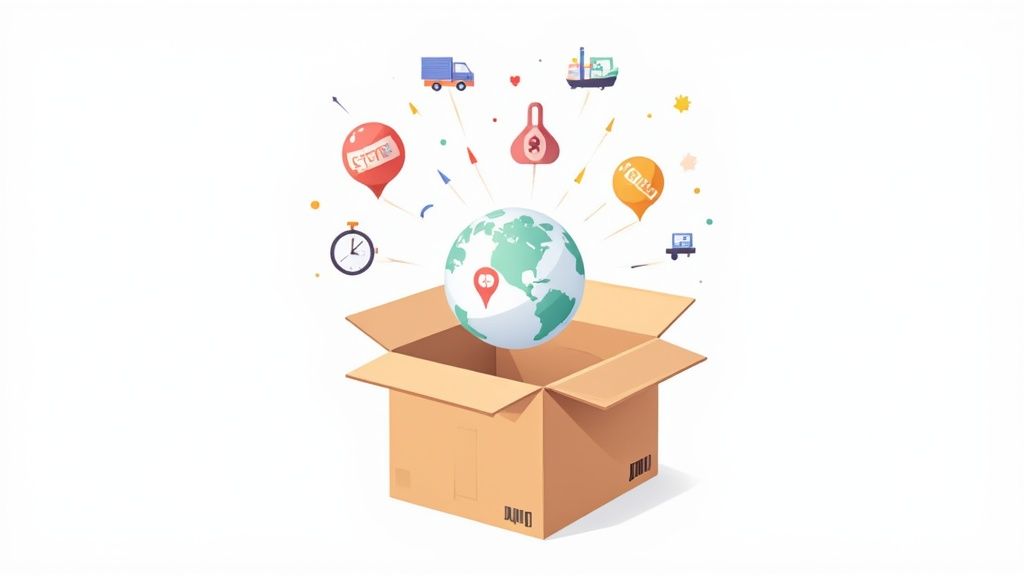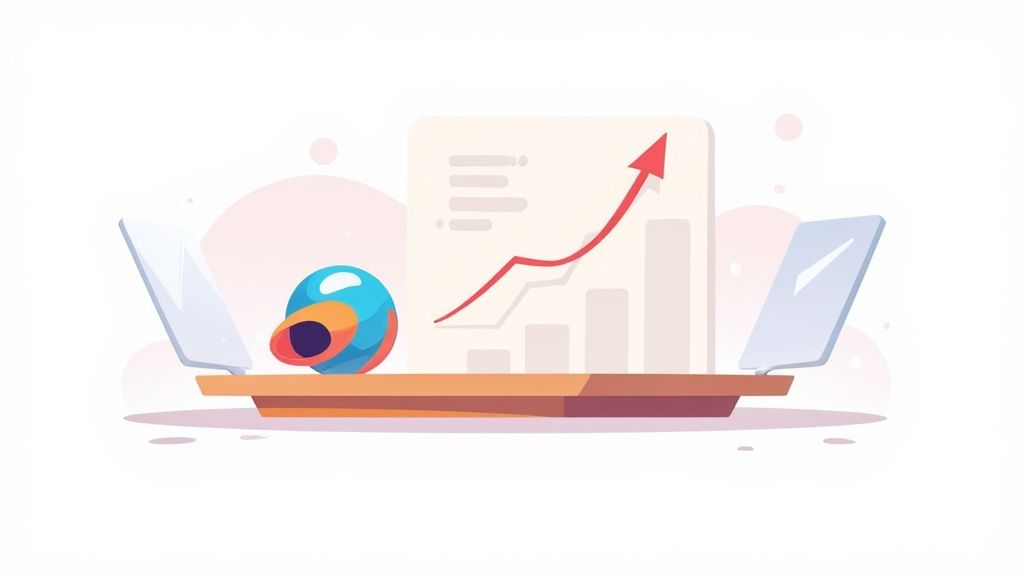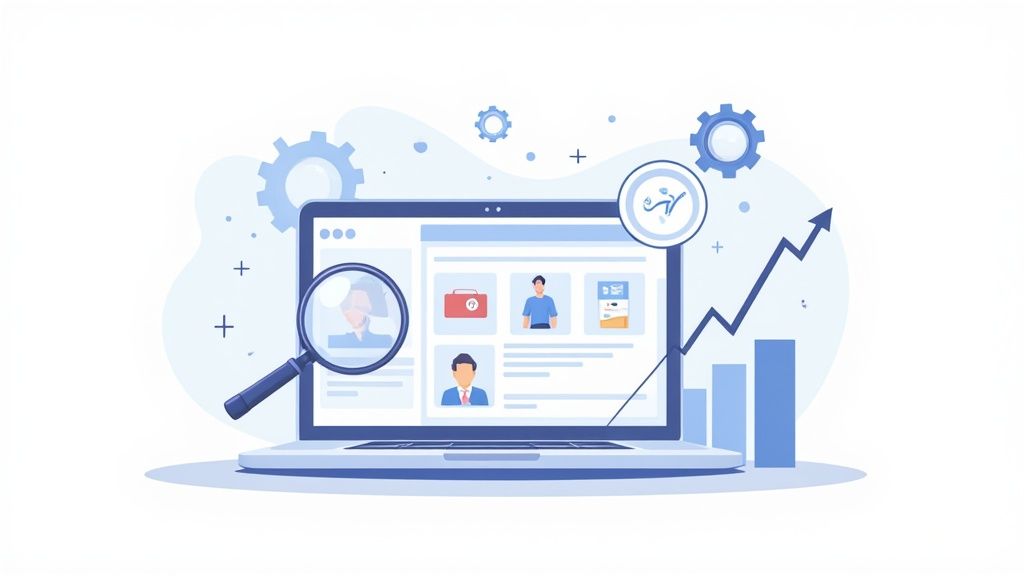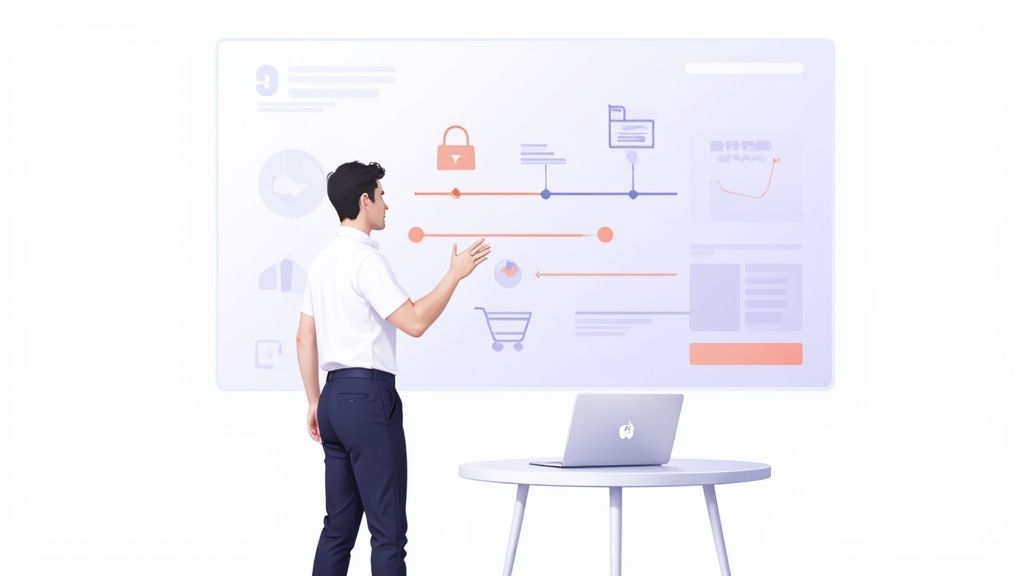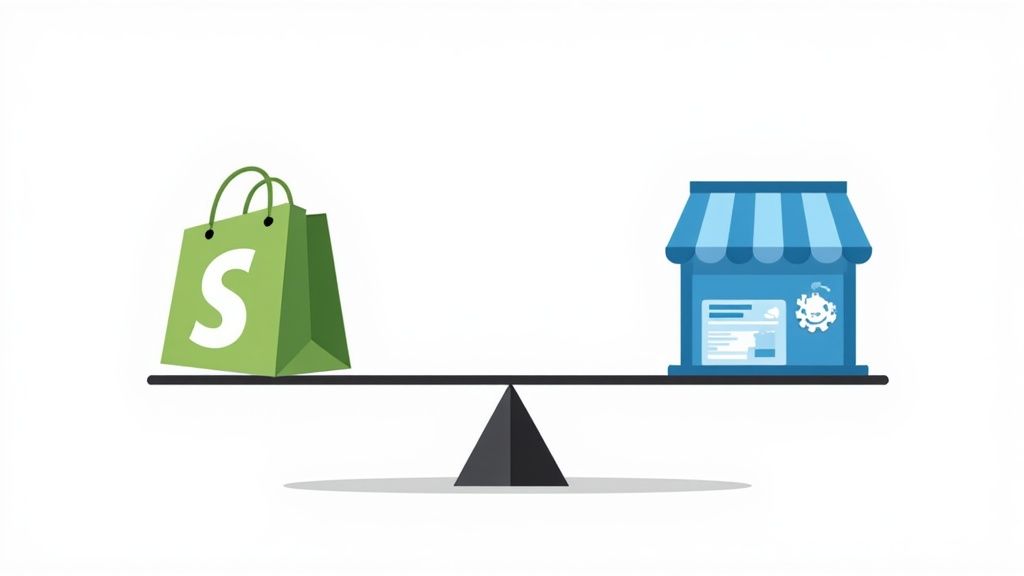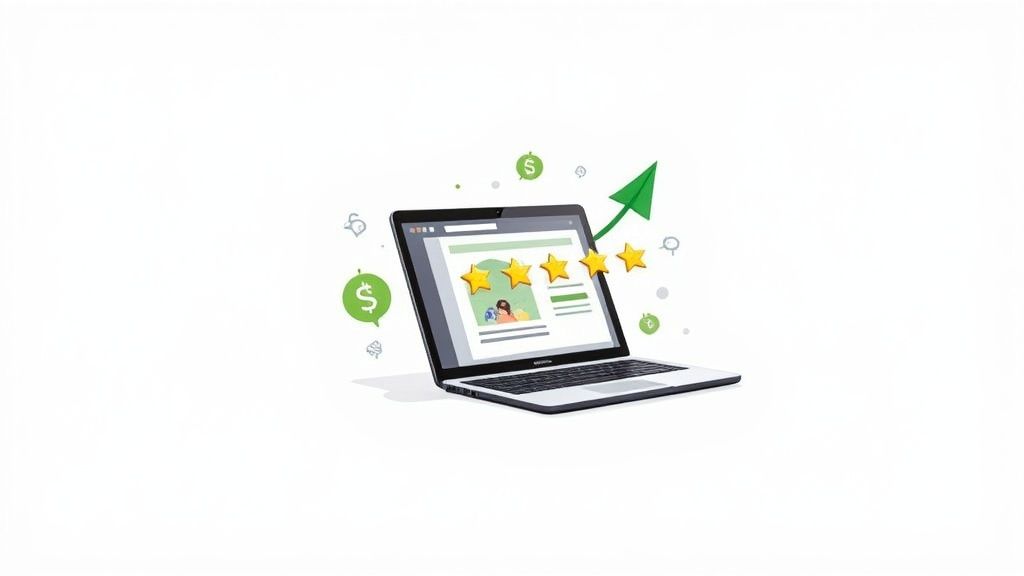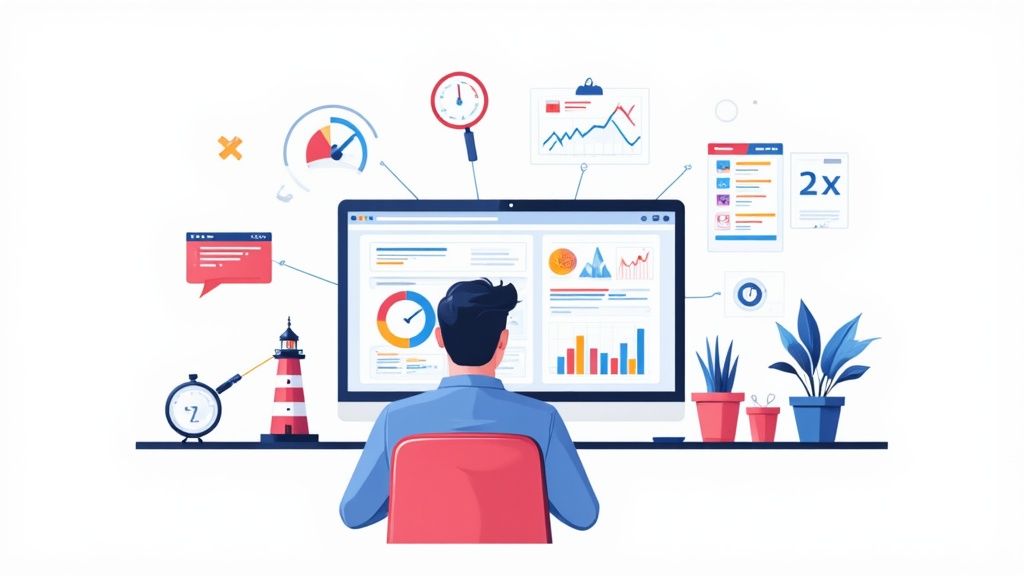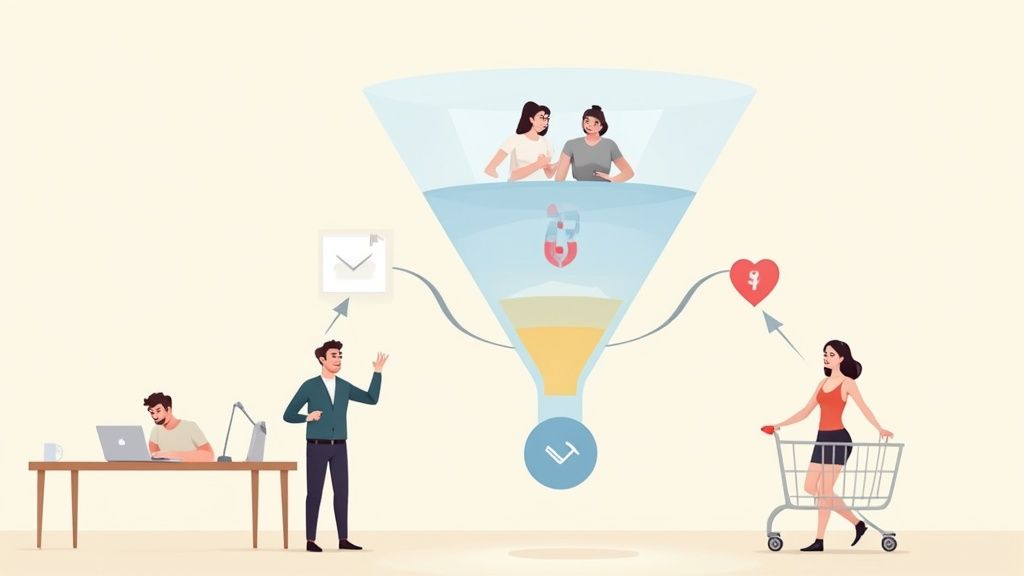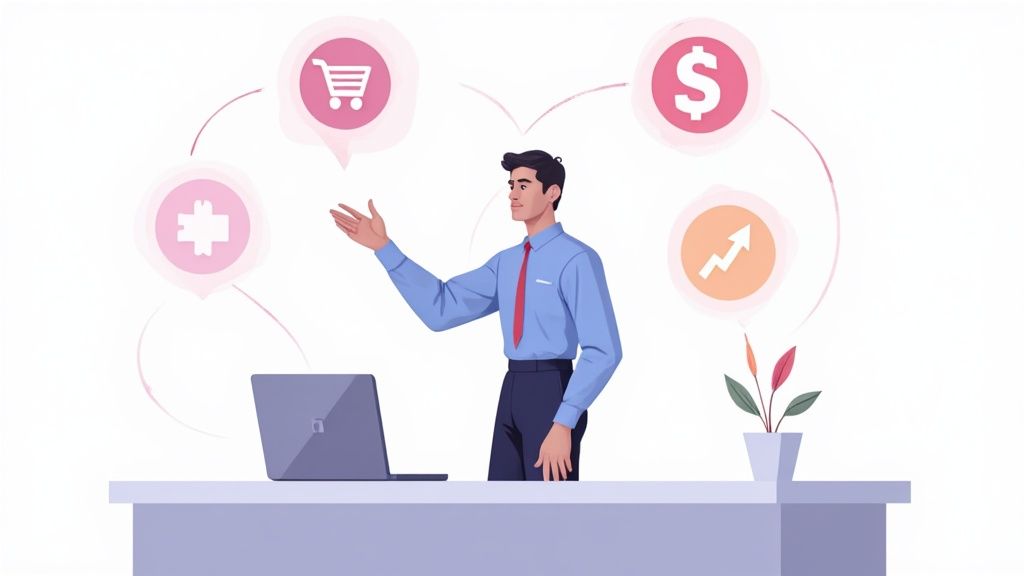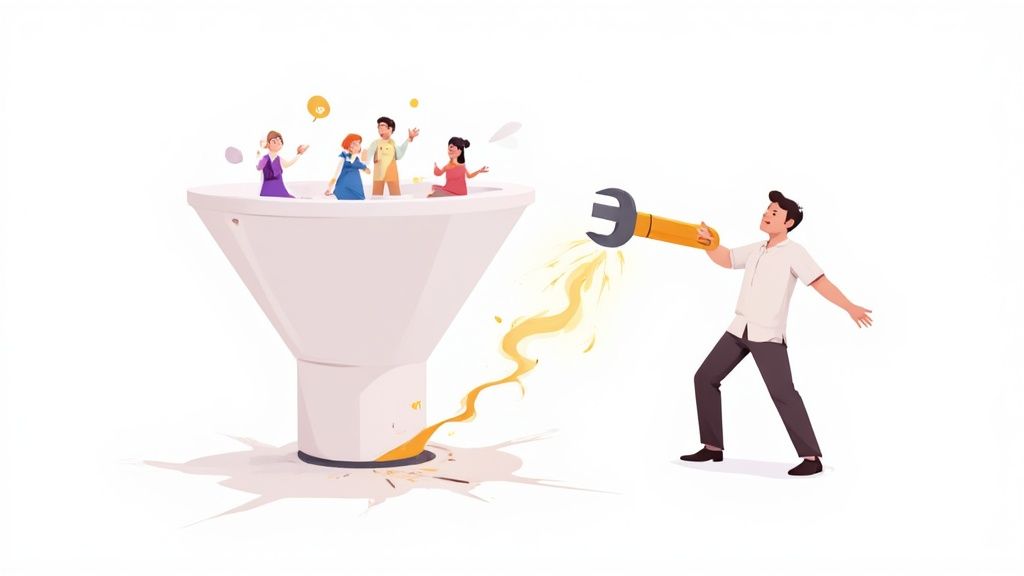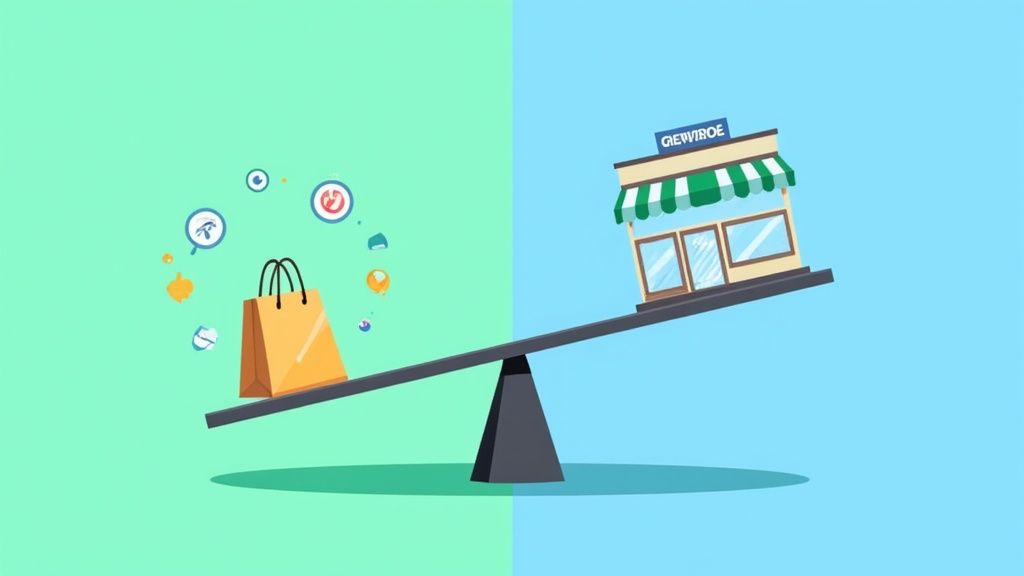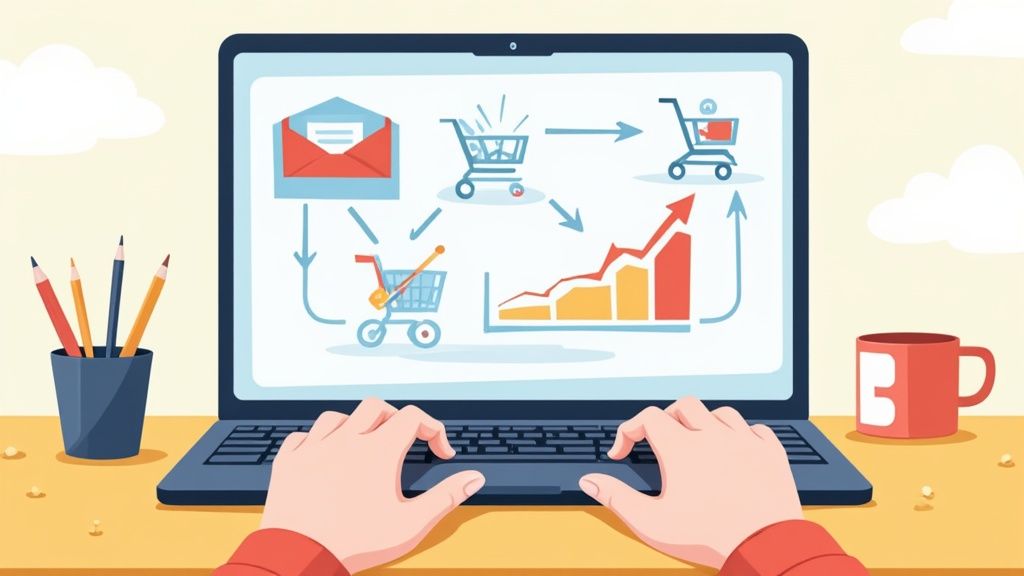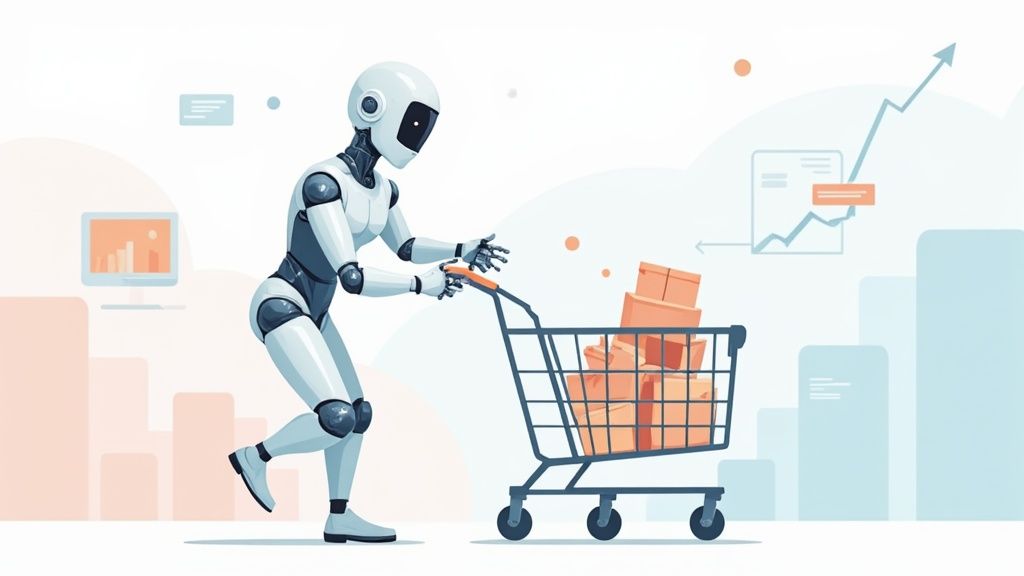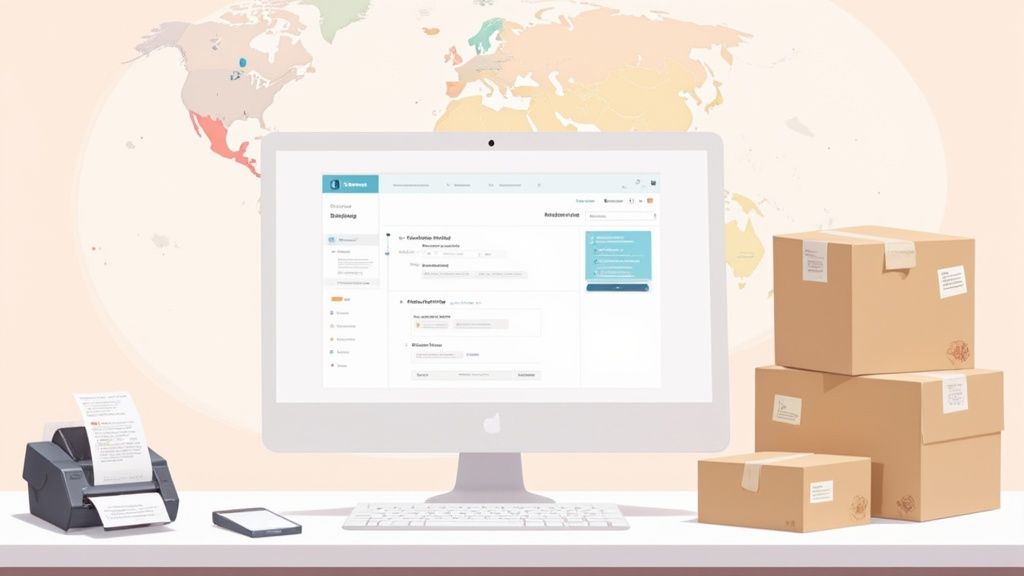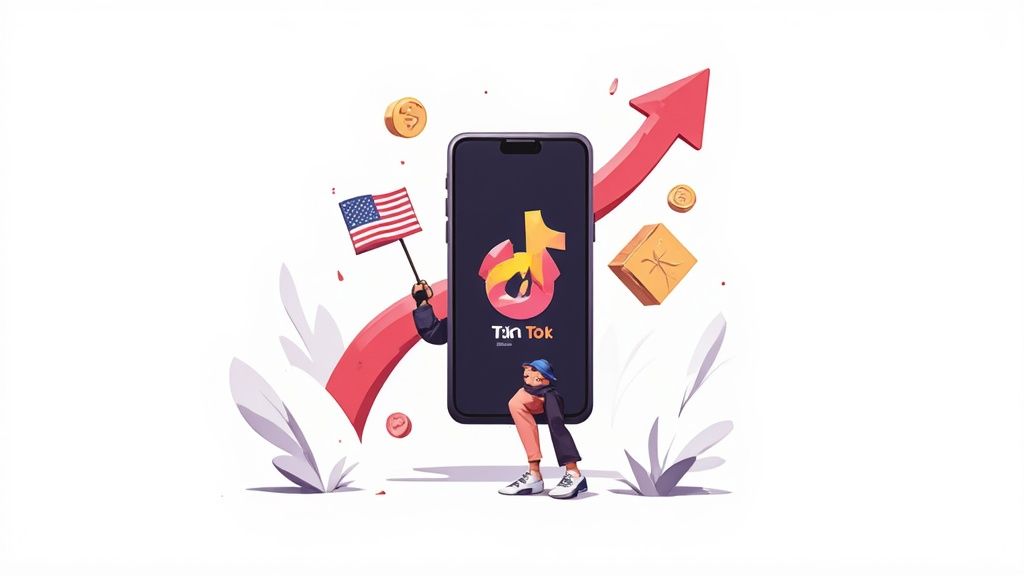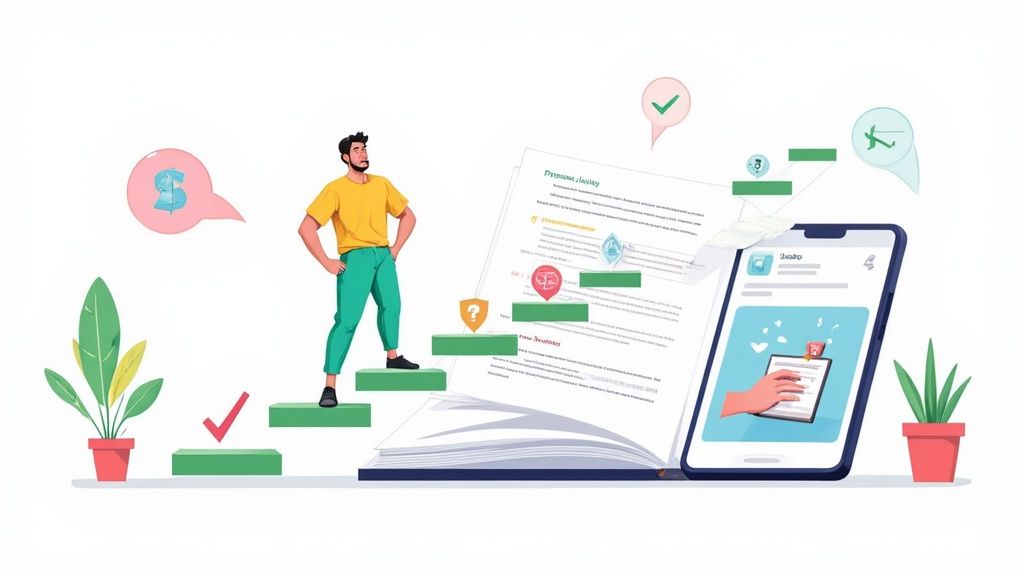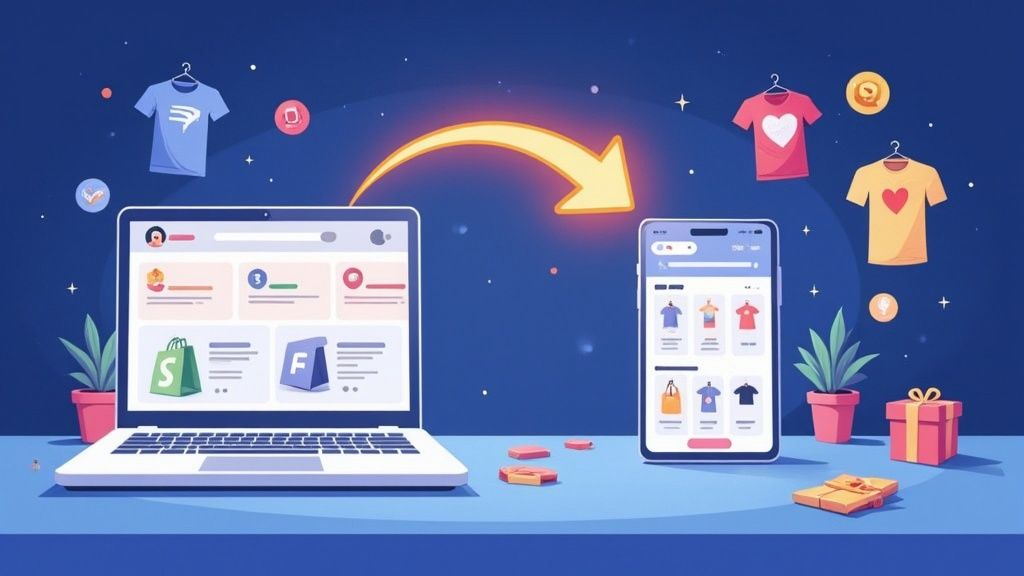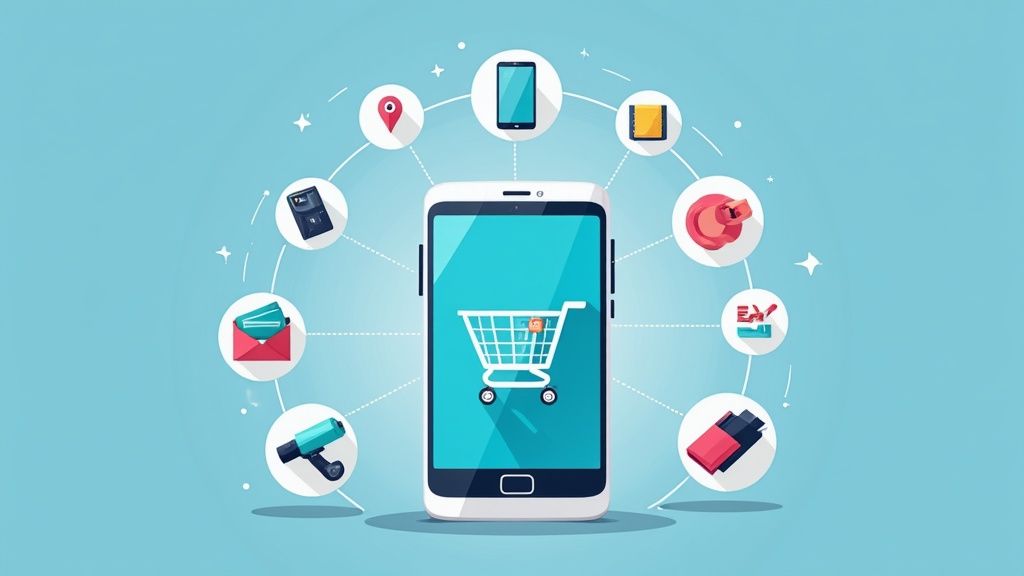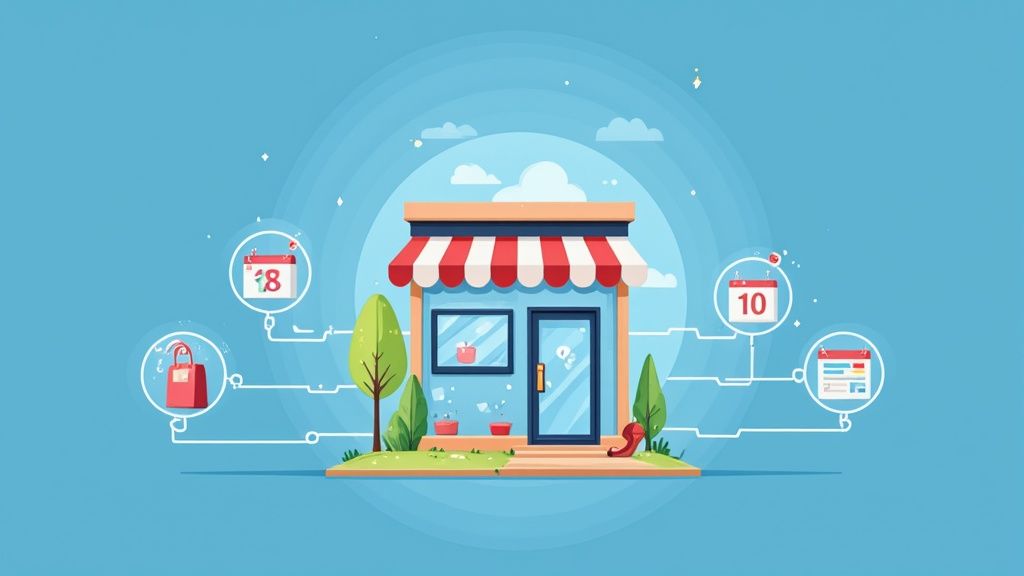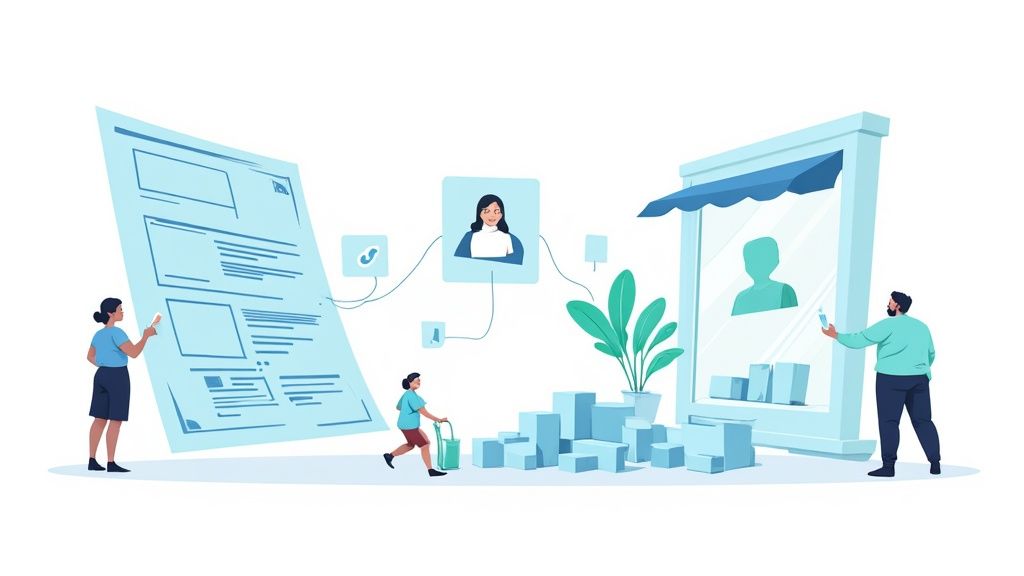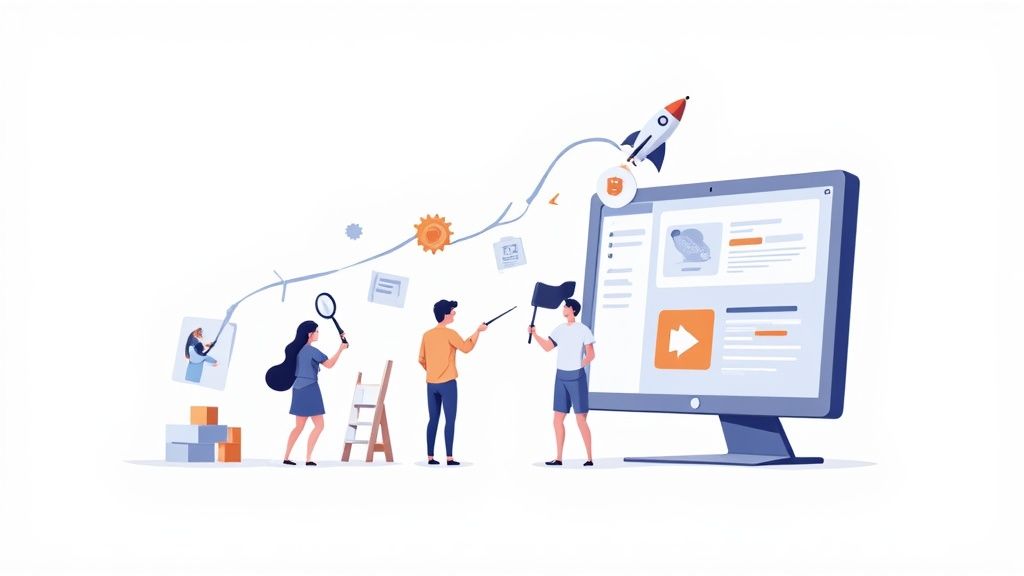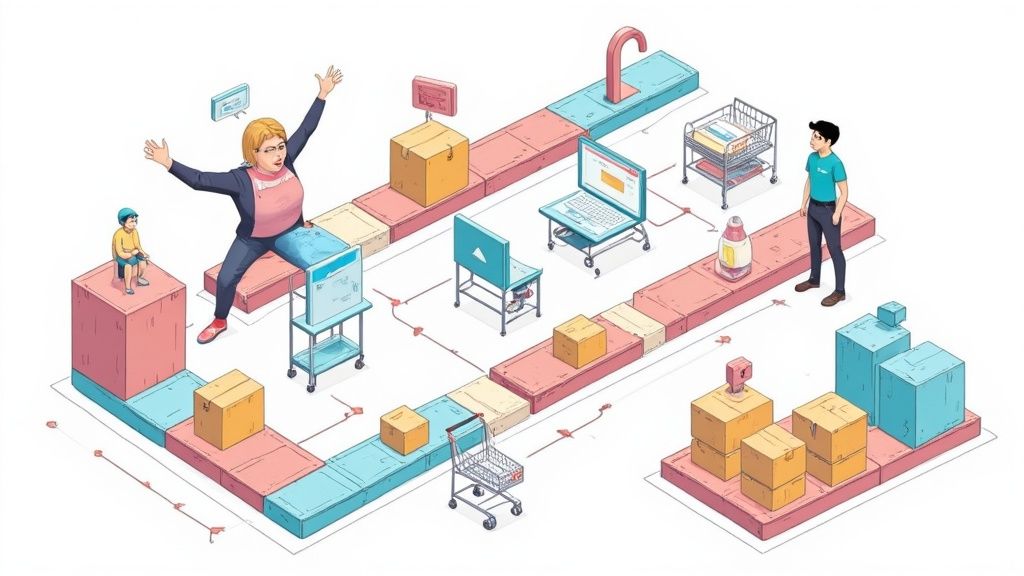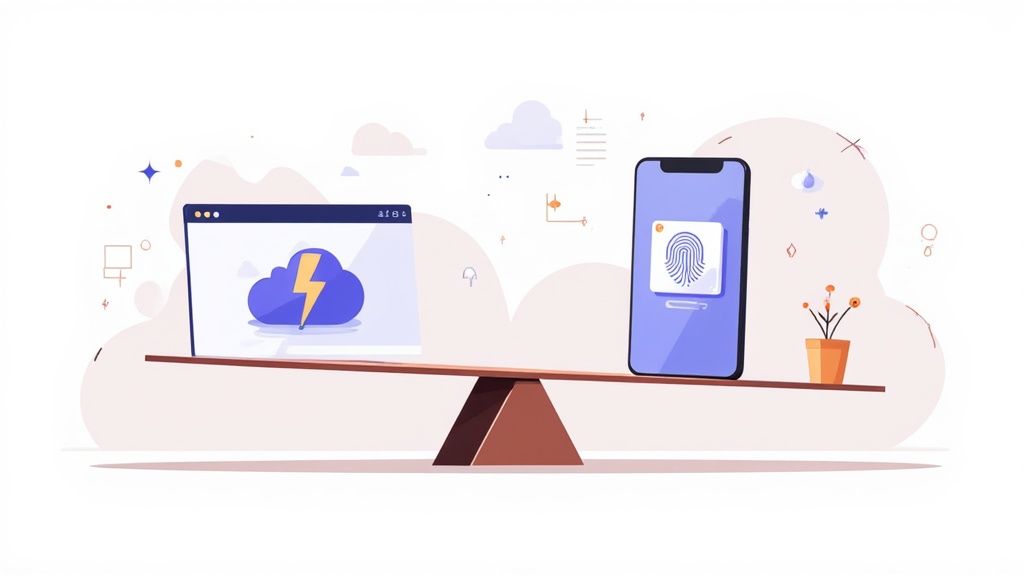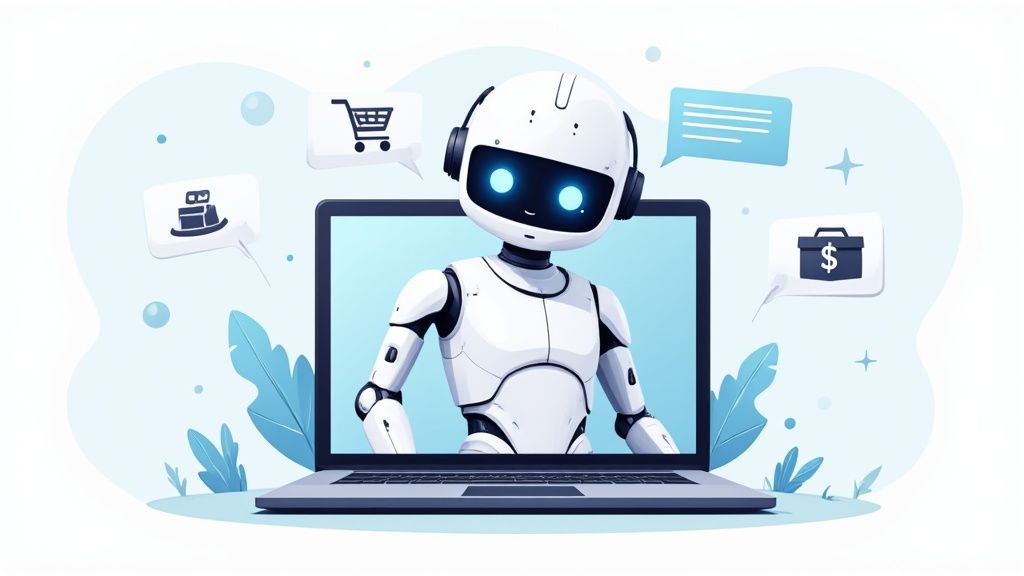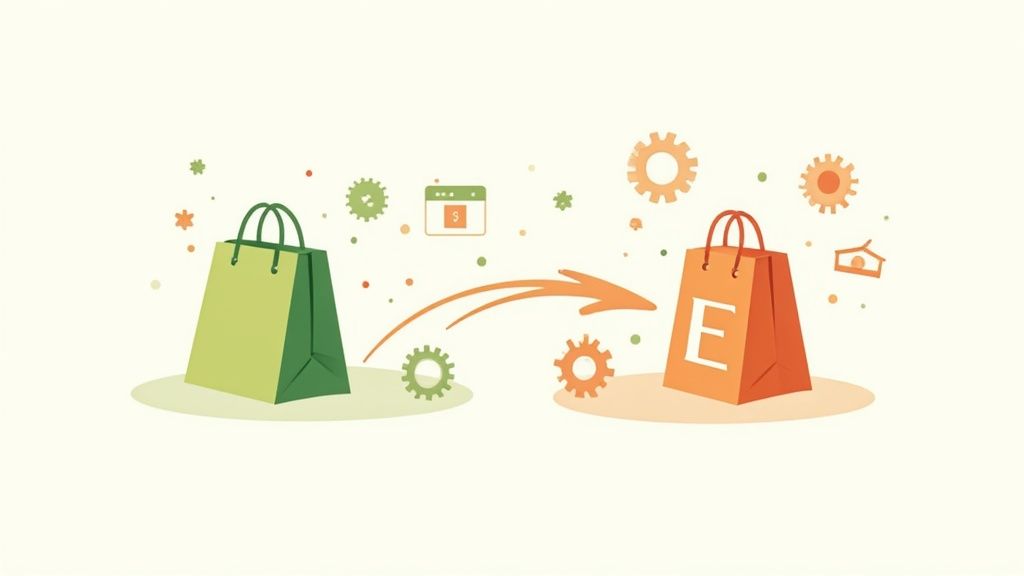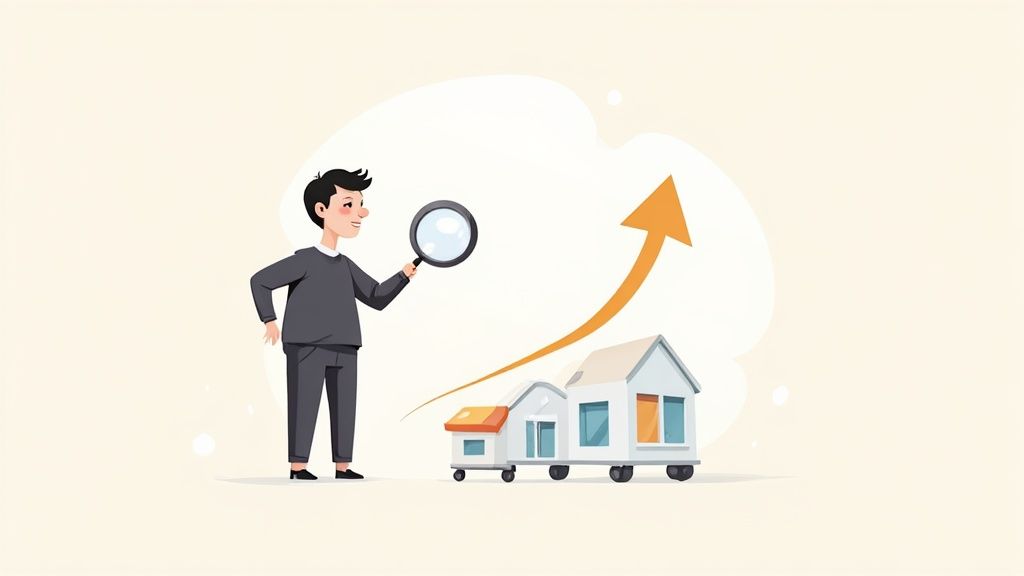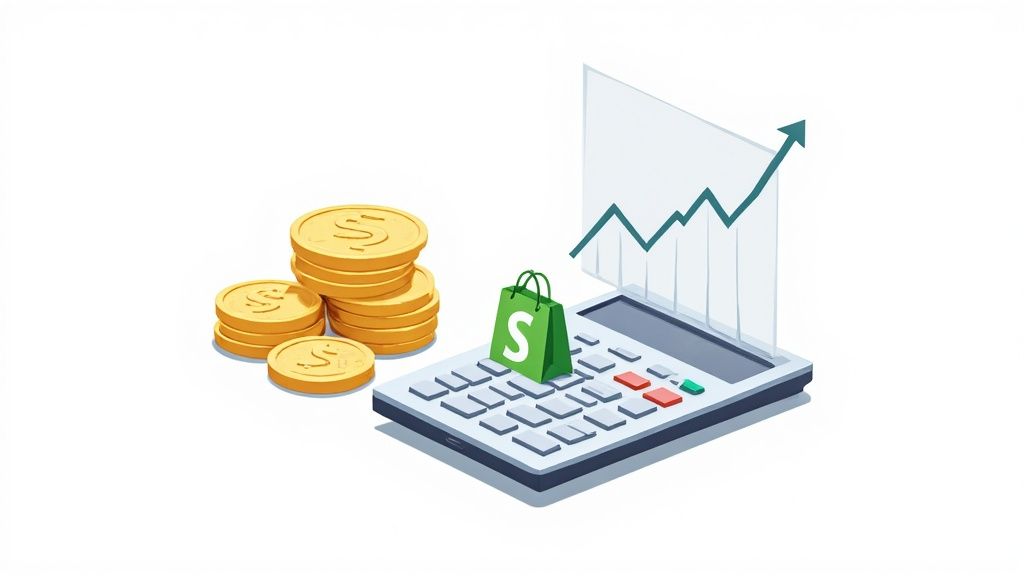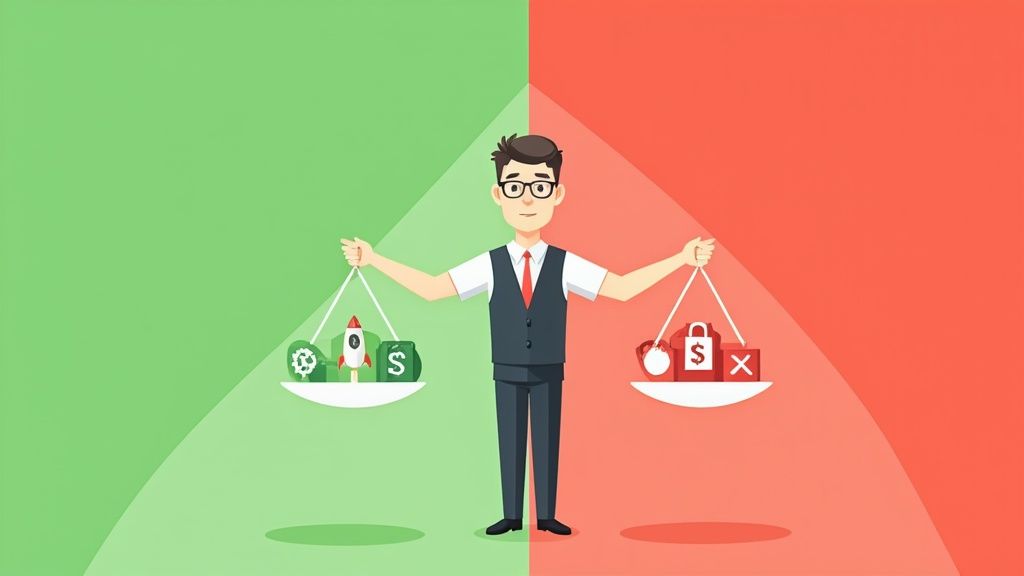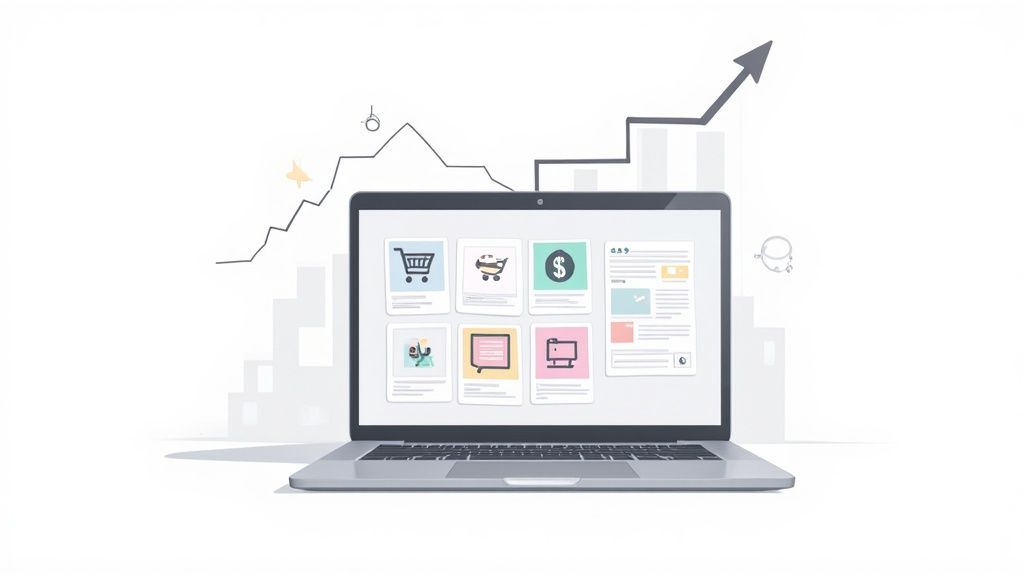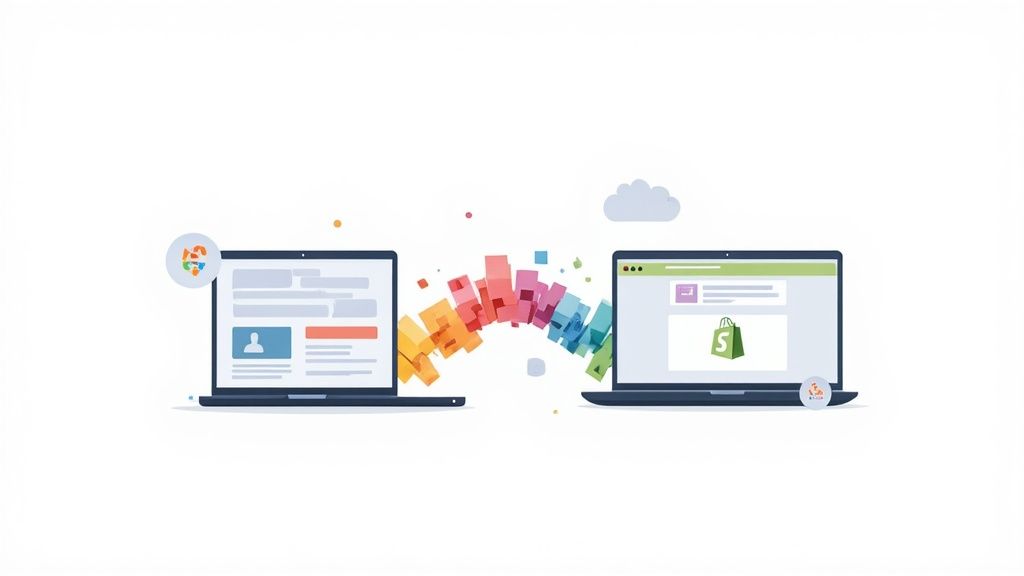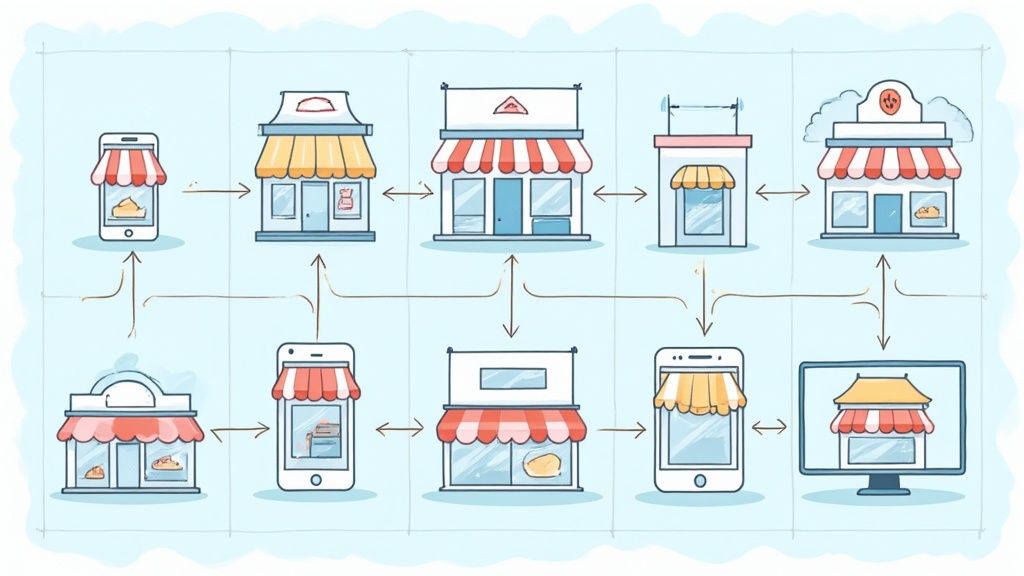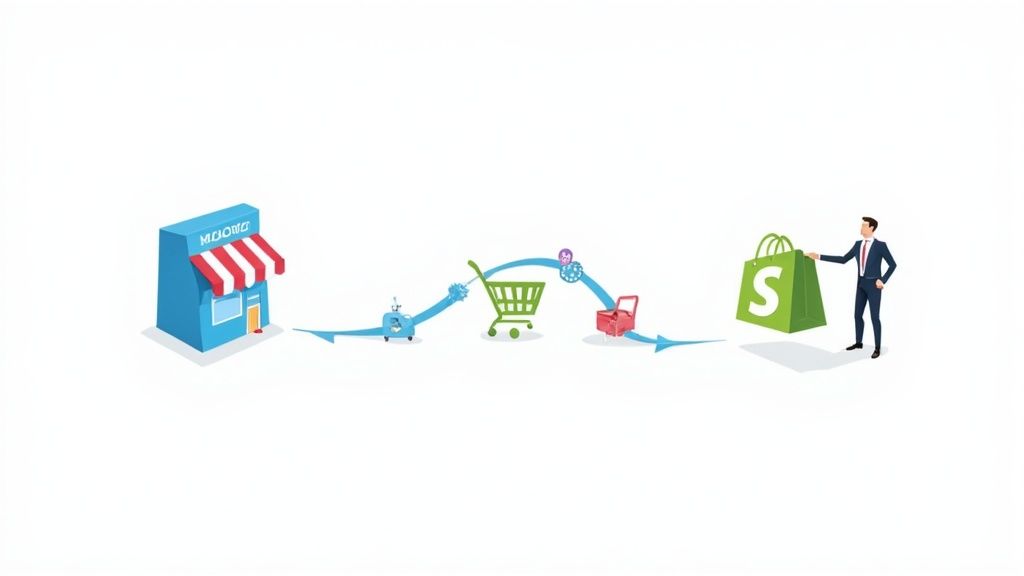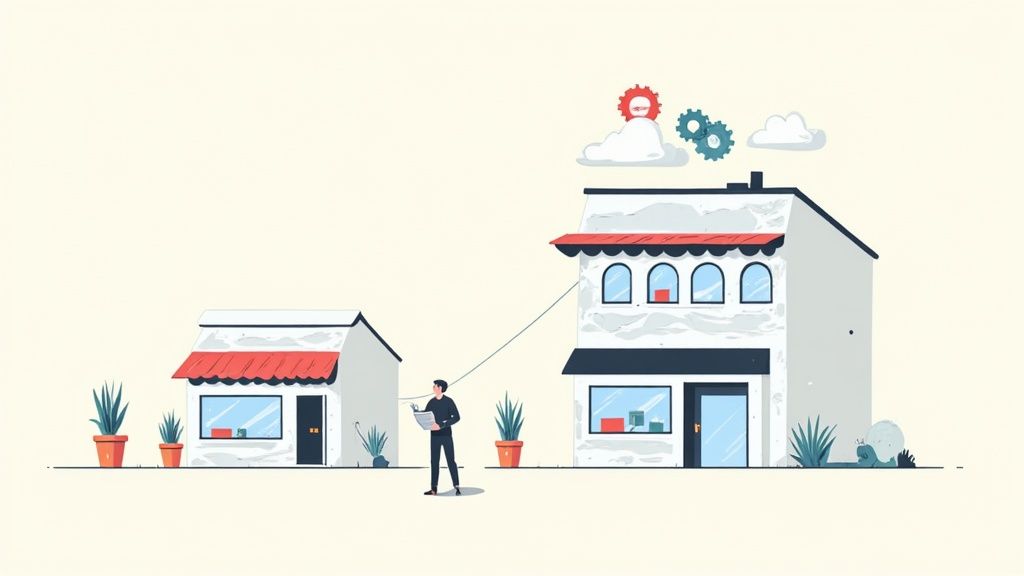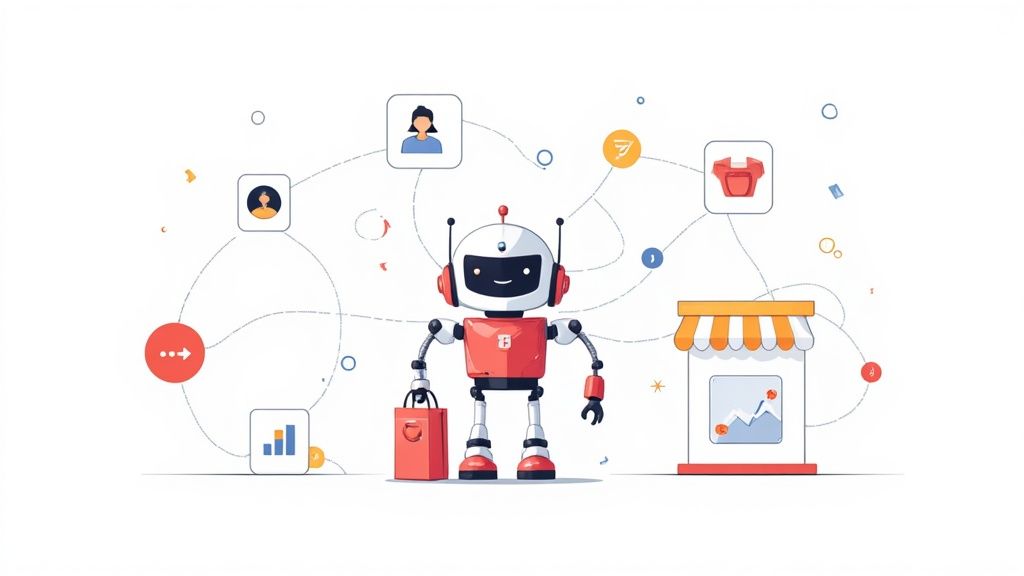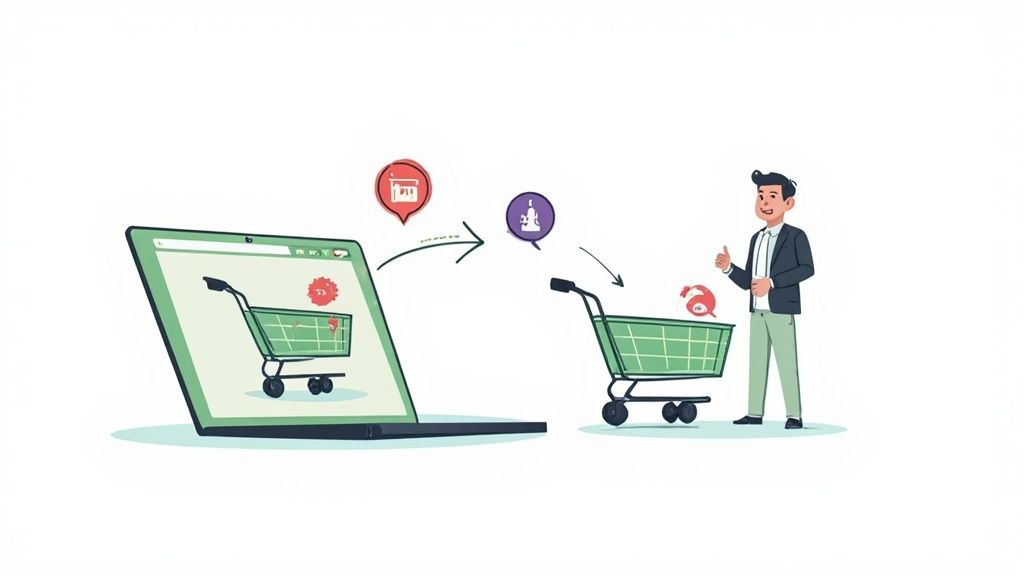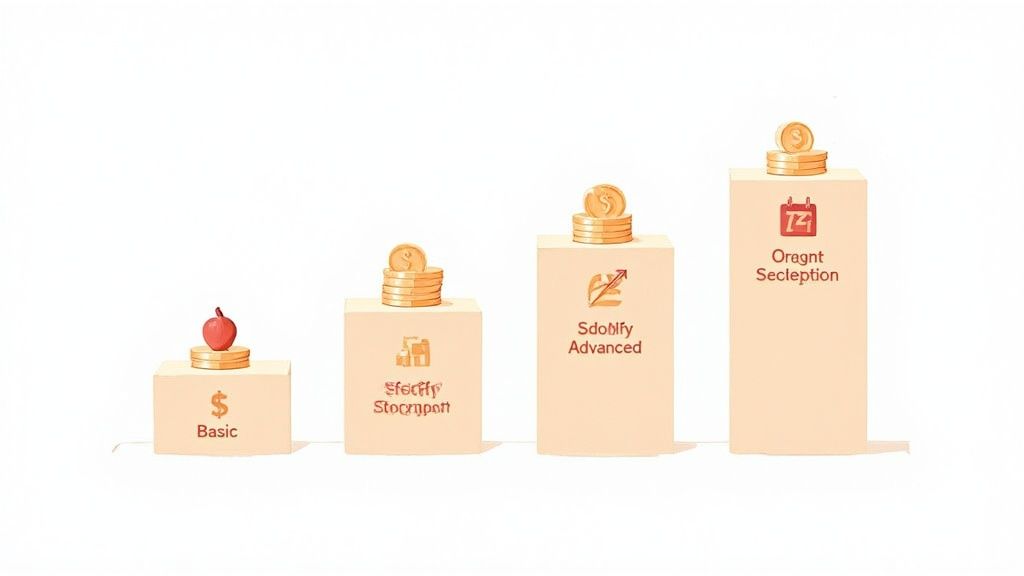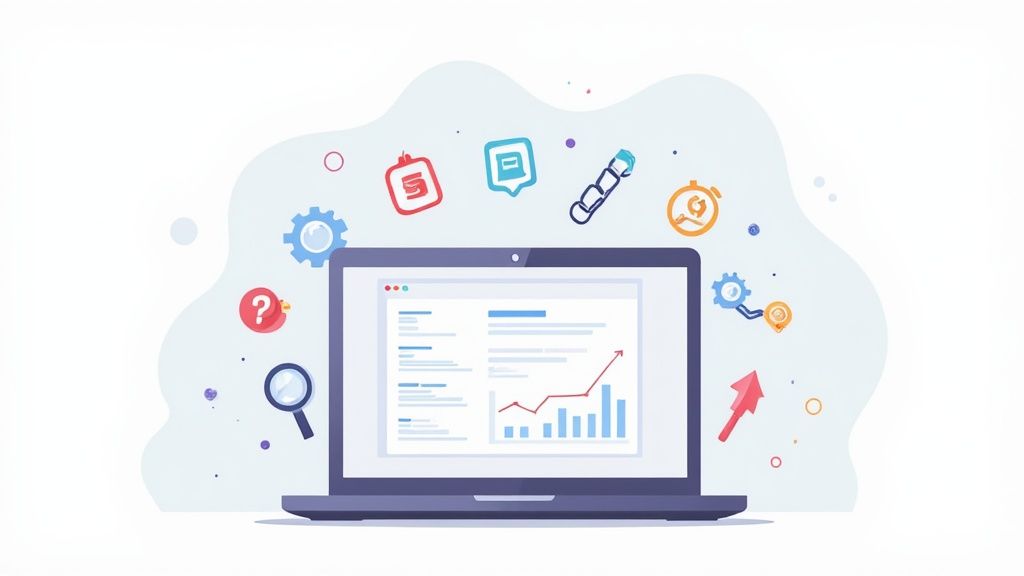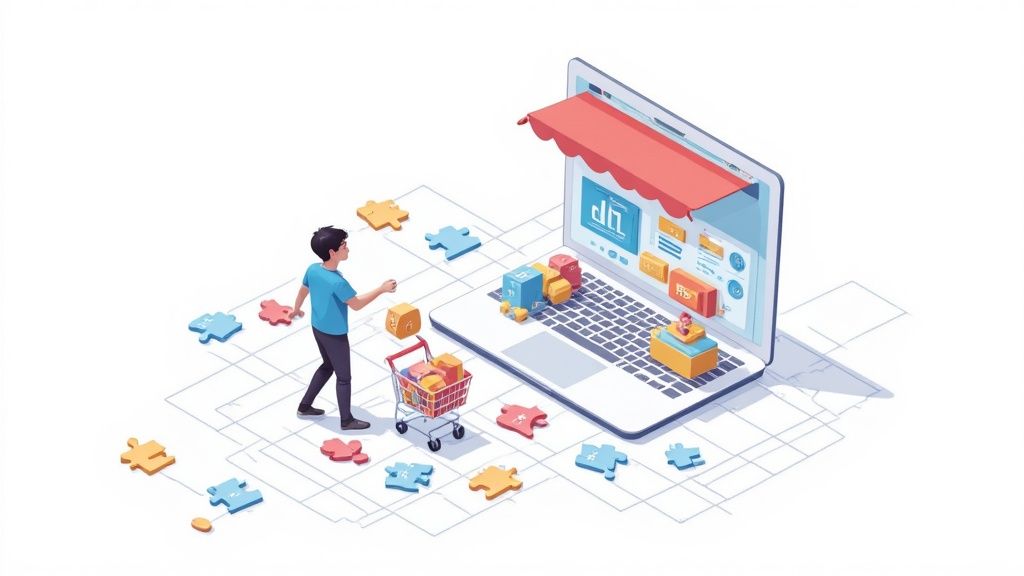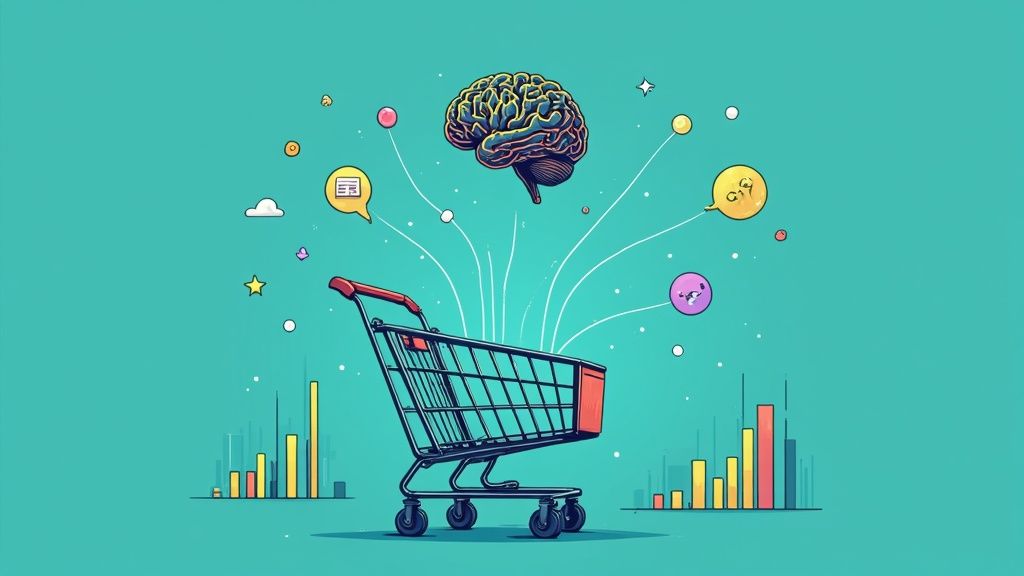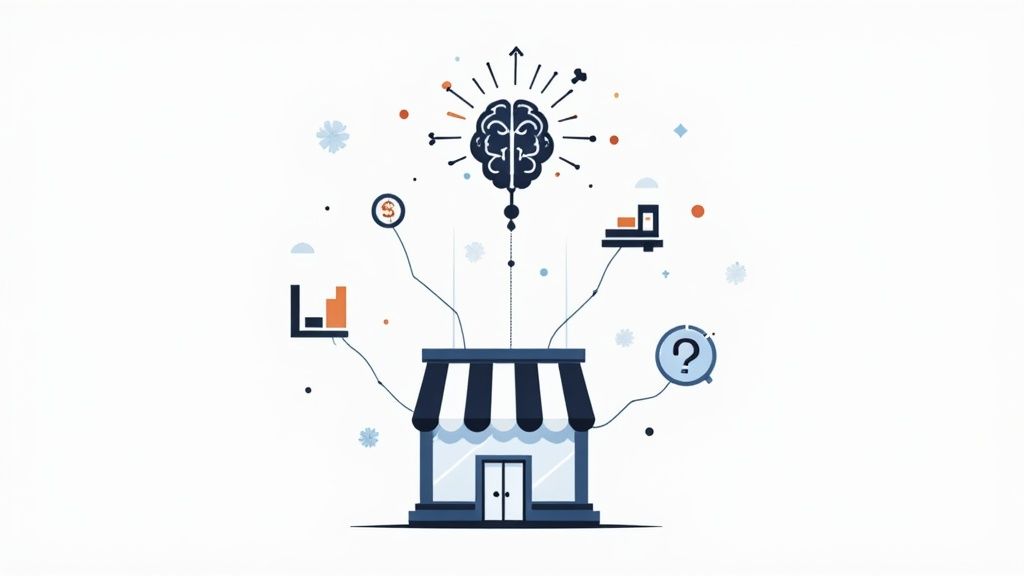
Let's be honest, old-school pricing strategies just don't cut it anymore. Machine learning price optimization is a complete departure from that static, rule-based world. Instead of manually setting prices and just reacting to whatever the market throws at you, this approach uses smart algorithms to proactively figure out the absolute best price for any product, at any given moment.
It’s the difference between trying to navigate a new city with a folded paper map versus using a live GPS that updates you on traffic in real-time. One gets you there eventually, maybe. The other finds you the best possible route, every single time.
From Static Pricing to Smart Predictions
Think about the sheer scale of pricing thousands of products in your eCommerce store. For years, the go-to methods have felt a bit like educated guesswork. You've got your cost-plus calculations, your frantic competitor matching, or your basic seasonal sales. These are the "paper maps" of the business world—static, rigid, and slow to change.
In today's market, that's a recipe for falling behind. Your competitors are adjusting their prices in minutes, not months. Customer demand can swing wildly based on the latest social media trend, and your inventory levels are in constant flux. Sticking to those old-school strategies means you're either leaving money on the table or losing customers to nimbler rivals.
The Shift to Proactive Pricing
This is where machine learning price optimization flips the script entirely. It's your business's live GPS, crunching thousands of data points at once to chart the smartest path forward. Instead of just looking in the rearview mirror, ML models are built to anticipate what's coming next.
This isn't just some futuristic concept; it's happening right now. The global AI market, which is the engine behind these pricing tools, was already valued at over $184 billion in 2024. And it's expected to rocket past $826 billion by 2030, which shows just how essential these technologies are becoming for staying competitive. You can explore more about how AI and machine learning will influence future pricing strategies.
What Machine Learning Analyzes
So, what's this "GPS" actually looking at? A machine learning model isn't just checking one or two things. It’s constantly digging through a rich blend of your own data and what's happening out in the market to spot patterns you'd never see on your own.
Here's a taste of what it's analyzing:
- Historical Sales Data: How did that 10% discount last quarter really affect sales volume?
- Competitor Pricing: What are your top three rivals charging for that same product right now?
- Customer Behavior: Do first-time buyers respond better to free shipping or a percentage-off deal?
- Inventory Levels: Are you overstocked on a particular item? It might be time for a strategic price drop to move that inventory.
- Market Trends and Seasonality: Is a holiday weekend coming up? Is there a viral trend about to cause a demand spike?
By pulling all this complex information together, machine learning doesn't just give you a price. It delivers a strategic recommendation tailored to hit a specific goal—whether that's crushing your revenue targets, beefing up your profit margins, or grabbing more market share. It turns pricing from a reactive chore into a serious competitive weapon.
How AI Decides the Perfect Price

Figuring out the perfect price for a product can feel like a mix of guesswork and intuition. But with machine learning, that art form becomes a precise science. The algorithm doesn't just pull a number out of thin air; it works like a master chef, carefully combining dozens of "ingredients" to land on the ideal price point.
The system crunches through complex relationships in your data that would be impossible for any human team to track at scale.
At its heart, the whole system is trying to understand one crucial concept: price elasticity. It’s just a fancy term for how much demand for your product changes when the price moves up or down. A machine learning model gets a feel for this by digging into your historical sales, past promotions, and market shifts, building a solid demand forecast for every single item you sell.
Let's say you're pricing a new pair of high-end headphones. A person might glance at the manufacturing cost and see what competitors are charging. An AI model, on the other hand, goes much, much deeper.
The Key Data Ingredients for Smart Pricing
The real magic of machine learning price optimization is the sheer volume and variety of data it can chew through at once. The model sifts through countless inputs to spot hidden patterns and connections that ultimately drive its final recommendation.
Think of each data point as a single clue. One clue on its own might not tell you much, but when you put thousands of them together, a very clear picture starts to form. This is what allows the AI to move past simple "cost-plus" thinking and build a strategy that reacts to the real world in real time.
A robust pricing model is only as good as the data it’s fed. These systems are designed to synthesize information from multiple sources, each providing a different piece of the puzzle.
Key Data Inputs for ML Pricing Models
By weaving all these data sets together, the AI can get incredibly specific with its pricing logic. It’s no longer just about setting a single price; it’s about finding the right price for the right person at the right time.
By synthesizing these diverse datasets, the AI can answer complex questions like, "What is the maximum price a first-time buyer from California will pay for these headphones during a holiday weekend, given our current inventory and our top competitor's price?"
An Example in Action
Let's circle back to our new headphones. The ML model starts by looking at historical sales for similar audio products you've sold. It sees that a 15% discount on a previous model boosted sales by 40%, but it also noticed a small dip in sales for a cheaper pair of earbuds—a classic case of product cannibalization.
Next, it scans competitor websites and finds that two major rivals have priced their comparable headphones $15 higher. At the same time, it picks up on an increase in social media chatter praising your brand's audio quality. It also takes into account that you’re sitting on a lot of inventory for this new product. If you're looking to dive deeper into this, it's worth learning how to strategically price your offers using AI.
After weighing all these variables—demand elasticity, competitor prices, social proof, and inventory risk—the model doesn't just spit out a single number. It might recommend a dynamic strategy: launch with a competitive price to grab initial market share, then automatically raise it by a few dollars as stock levels decrease and positive reviews start rolling in.
This is the kind of sophisticated, data-backed decision-making that truly sets machine learning apart.
The Engines Behind Smart Pricing
To really get what machine learning price optimization is all about, you need to pop the hood and look at the algorithms making these smart decisions. Don't worry, you don't need to be a data scientist to get the main ideas. Think of these algorithms as different kinds of engines, each built for a specific job—from guessing future demand to reacting to market shifts on the fly.
At a high level, these models are just incredibly sophisticated pattern-finders. They dig through mountains of data—your sales history, what your competitors are doing, customer behavior—to spot relationships that can guide your pricing. By understanding the main types of algorithms at play, you can get a much better feel for how this tech solves real-world business problems.
This visual below breaks down how crucial data points like historical sales, competitor pricing, and customer segments are the bedrock for these powerful models.

It’s pretty clear from this hierarchy: without a solid, multi-layered data foundation, even the most advanced algorithm is going to fall flat.
Regression Models Predicting Demand
One of the most common engines you'll find in machine learning pricing is the regression model. Its main job is to predict a continuous number, like sales volume or revenue, based on a bunch of different inputs. In plain English, it answers questions like, "If we drop the price of this T-shirt by 10%, how many more can we realistically expect to sell?"
Regression analysis is the true workhorse behind demand forecasting. It studies your past data to figure out the relationship between how you price an item and how many units you sell, a concept economists call price elasticity.
These models are fantastic for:
- Forecasting Sales: Predicting future sales volume at different price points.
- Setting Initial Prices: Figuring out the sweet spot for a new product's launch price.
- Promotion Planning: Estimating how much a planned discount will actually lift your revenue.
By understanding these cause-and-effect connections, businesses can stop guessing with their discounts and start building data-driven promotional strategies. This is a huge piece of predictive analytics for eCommerce, which we dive into deeper in our full guide.
Classification Models Segmenting Customers
Next up, we have classification models. Instead of predicting a number, these algorithms slot items into a specific category or group. Think of it as an intelligent sorting hat for your business. When it comes to pricing, their biggest superpower is customer segmentation.
A classification model can chew through customer data—purchase history, browsing behavior, location—and sort them into useful segments. For instance, it might identify distinct groups like "loyal high-spenders," "bargain hunters," and "first-time visitors."
This kind of segmentation is a game-changer. It lets a business ditch one-size-fits-all pricing and instead create targeted offers that actually connect with different customer mindsets, which is key to boosting conversion rates and lifetime value.
Once you have these segments, you can build custom pricing strategies. Maybe your loyal customers get early access to new products at a premium price, while your price-sensitive group gets a time-sensitive discount to nudge them toward a purchase.
Reinforcement Learning Adapting in Real Time
The most advanced engine in the toolbox is reinforcement learning (RL). If regression and classification models learn from a fixed set of historical data, reinforcement learning learns by doing. It's designed to make a series of decisions in a live environment to maximize a long-term goal, like total profit.
Imagine it as a self-adjusting thermostat for your pricing strategy. The RL agent (the "thermostat") is constantly experimenting with tiny price changes.
- If a price tweak leads to more profit (the "temperature" you want), it gets a positive reward and learns that was a good move.
- If an adjustment hurts profits, it receives a negative signal and learns to avoid doing that again.
This trial-and-error process, run thousands of times in a simulated environment, helps the model build a highly adaptive pricing policy. It can automatically react to sudden market trends, competitor price cuts, or unexpected surges in demand without needing a human to step in. This makes RL the perfect fit for businesses in fast-moving, competitive markets where being able to adapt in real time gives you a serious advantage.
Measuring the Real-World Business Impact
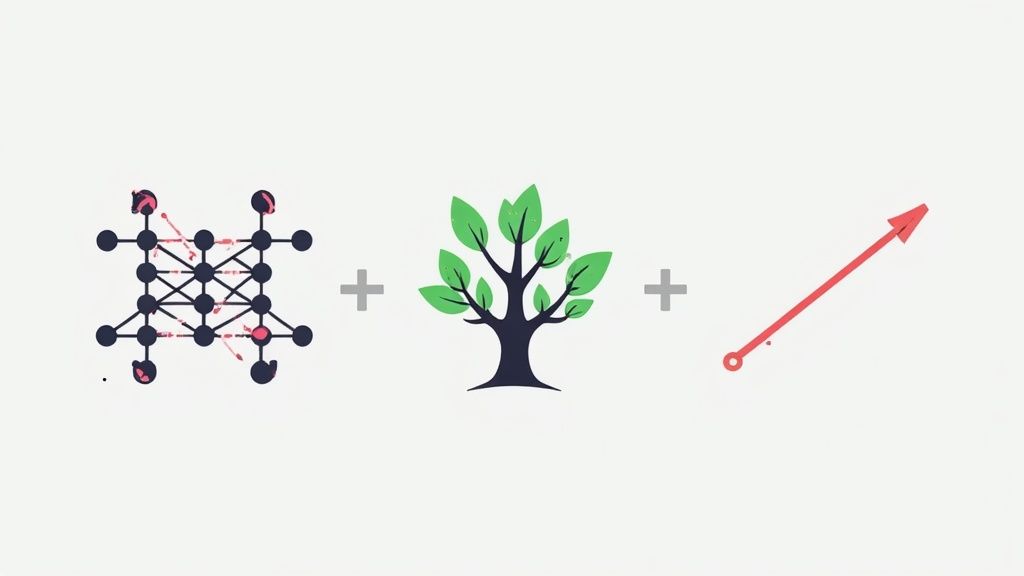
While the algorithms are interesting, what really matters is what machine learning price optimization can do for your bottom line. Let's move past the theory. The tangible results are where this technology truly shines, turning pricing from a simple task into a serious driver of financial growth.
We aren't talking about tiny, incremental gains here. We're talking about fundamentally improving core business metrics. This is exactly why the price optimization market is projected to hit $2.0 billion by 2027, growing at a compound rate of 12.7%. Businesses that get on board often see gross profits jump by 5% to 10%, not to mention significant boosts in overall revenue. You can find more insights on the future of eCommerce pricing and how it’s changing the game.
Boosting Revenue and Profit Margins
The most immediate and obvious impact of smart pricing is on your revenue and profit margins. Let's be honest, traditional pricing models almost always leave money on the table. A static price can be too low when demand spikes or too high during a quiet period, meaning you’re either missing out on profit or sales.
Machine learning models fix this by finding the sweet spot in real-time.
- During a Demand Spike: Picture a product suddenly going viral. An ML model catches this surge instantly and can suggest a slight price increase to capture maximum revenue while demand is hot, without scaring off buyers.
- For Slow-Moving Inventory: Instead of resorting to deep, margin-killing clearance sales, the system can figure out the highest price that will still get that aging stock moving, protecting your profitability.
By constantly adjusting to find the perfect balance between what a customer is willing to pay and your business goals, machine learning ensures you are maximizing the value of every single transaction.
This dynamic approach means you're no longer relying on gut feelings or waiting for quarterly pricing reviews. The system is always working in the background to protect and grow your margins.
Enhancing Customer Lifetime Value
But smart pricing isn't just about grabbing maximum profit from a single sale. It's also a surprisingly powerful tool for building long-term customer relationships. By understanding different customer segments, machine learning helps you deliver pricing that feels fair and personal, which is the secret sauce for boosting customer lifetime value (CLV).
For instance, a model might identify a group of "bargain hunters" who only ever buy during a sale. Instead of showing them the same prices as your loyal, full-price customers, you can target them with specific, time-sensitive promotions that get them to buy without devaluing your brand for everyone else.
This leads to a few great outcomes:
- Increased Loyalty: Customers who feel they’re getting a fair deal are far more likely to come back.
- Higher Conversion Rates: The right offer at the right time can easily turn a hesitant browser into a buyer.
- Improved Segmentation: You gain a much deeper understanding of what actually motivates different customer groups, which makes all of your marketing smarter.
When you tailor the price to the customer's perceived value, you're creating a better, more personalized shopping experience. This builds loyalty and encourages repeat business, turning one-time buyers into genuine fans of your brand.
Solving Complex Pricing Puzzles with AI
Human intuition is a powerful tool in business, but it has its limits. When you're managing a massive product catalog, even the sharpest pricing manager can't mentally track how changing the price on one item ripples across thousands of others. This is where machine learning price optimization stops being a helpful tool and becomes an absolutely essential part of your strategy.
AI is built to unravel the kind of complex, interconnected pricing puzzles that are simply impossible for a human to solve. It finds the invisible threads connecting your products, predicting how a single discount might trigger a chain reaction of buying behaviors across your entire store. This is how you graduate from pricing individual items to optimizing your entire product ecosystem.
Uncovering Hidden Product Relationships
Two of the trickiest pricing challenges are product cannibalization and the halo effect. You’ve probably seen them in action. Cannibalization is when a sale on one product just steals revenue from a similar, full-priced item. The halo effect is the opposite—a popular "hero" product drives sales of related, high-margin accessories.
A human analyst might spot that a 15% discount on a flagship laptop boosted its sales, but they’d likely miss the subtle effects downstream. Did that sale cannibalize a slightly older, more profitable model? Or did it create a halo effect, pulling in extra sales of mice, keyboards, and software licenses?
An ML model figures this out automatically and at a massive scale. It can pin down the precise financial impact of these relationships, giving you a crystal-clear picture of your net profitability.
An Electronics Store Example
Imagine an eCommerce electronics store decides to run a promotion on a new laptop, dropping the price by what seems like a minor $50. A quick look at the numbers at the end of the month might show a modest bump in laptop sales. The team might call it a mild success and move on.
But a machine learning model would dig much, much deeper. It connects the dots across your entire sales history.
- It would flag that for every discounted laptop sold, there was a 35% increase in purchases of high-margin accessories like premium cases and antivirus software in the same transaction.
- The model would also confirm that the promotion didn't significantly steal sales from other laptops in the same price range.
The AI’s conclusion is far more powerful: that small $50 laptop discount was actually a highly profitable move. The win wasn't the laptop itself; it was the trigger for a surge in high-margin add-ons. This is the kind of hidden victory that manual analysis almost always misses.
This ability to see the full impact of pricing decisions is what separates basic tactics from advanced strategy. The table below breaks down the difference between the old way and the new way of thinking about pricing.
Manual Pricing vs AI-Powered Optimization
Ultimately, manual methods are like trying to navigate a maze with a flashlight, seeing only what's directly in front of you. Machine learning provides the full map, showing you every connection and every dead end so you can find the most profitable path forward.
Optimizing the Entire Ecosystem
This ability to see the bigger picture is what sets machine learning for retail apart. Instead of just setting a price for a single SKU, the system optimizes for the total value of a customer's shopping cart and, by extension, their lifetime value. For a deep dive into this topic, check out our guide on machine learning for retail.
Once you understand these intricate relationships, you can design much smarter strategies. You might learn that a small, targeted discount on a popular video game console (a low-margin item) is the single most effective way to drive high-margin game and controller sales. Suddenly, that discount isn't a cost—it's a powerful and profitable promotional tool. This holistic view turns pricing into a true strategic lever for growth.
Your Roadmap to Implementing Smart Pricing
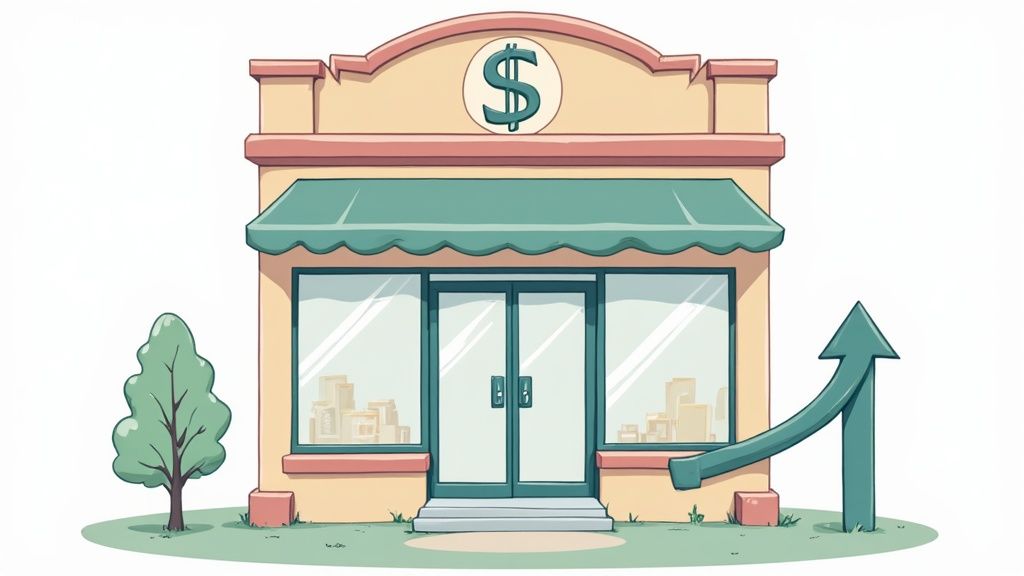
Jumping into machine learning price optimization can feel like a massive project, but you can break it down into a few clear, manageable phases. This isn't about flipping a switch and hoping for the best. It’s a deliberate process of getting your data in order, picking the right tools, and carefully weaving them into how you already do business.
Think of it like building a new house. You wouldn't just start throwing up walls without a solid blueprint. The same idea applies here. A clear plan is what separates a successful launch from a frustrating false start, ensuring you build a pricing engine that adds real value from day one.
Phase 1: Laying the Data Foundation
Your historical data is the bedrock of any smart pricing system. Before any algorithm can work its magic, you need to pull together the right information. Messy, incomplete data is the number one reason these projects fail, so putting in the time here is non-negotiable.
Your main job is to collect clean, structured data from the last one to two years. The better the information you feed the model, the sharper and more reliable its predictions will be.
Start by getting these key datasets in one place:
- Transaction History: This means order dates, products sold, quantities, and the final price paid for every single sale.
- Product Information: Gather all the important details like SKU, category, brand, and your cost for each item.
- Customer Data: If you have it, pull in segmented data like new vs. returning customers or where they're located.
This first phase is all about creating a single source of truth. Once your data is clean and organized, you're ready to move on to the more exciting part: picking your tools.
Phase 2: Choosing Your Path—Build vs. Buy
With your data ready to go, you’ve hit a fork in the road. Do you build a custom pricing model from the ground up, or do you partner with a specialized SaaS provider? Each route has its pros and cons, and the right choice really depends on your business.
The "build" approach means hiring a team of data scientists and engineers to create your own system. This gives you total control and customization, but it demands a huge investment in time, money, and talent. It’s usually a path for massive enterprises with truly unique pricing challenges.
The "buy" approach, using a SaaS platform, is what has made machine learning price optimization a real option for businesses of all sizes. These platforms handle all the heavy lifting—the complex modeling and infrastructure—so you can connect your data and start seeing results quickly.
For most eCommerce brands, a SaaS solution is the fastest and most direct path to seeing a return on your investment. It lets you tap into powerful technology without the massive upfront cost and headache of building an in-house system.
Phase 3: Integration and Continuous Monitoring
The final step is to bring your new pricing system to life. This means integrating your chosen solution with your eCommerce platform—whether it's Shopify, WooCommerce, or something else—so price recommendations can be reviewed and rolled out smoothly.
But going live isn't the finish line. The market is always shifting, and your model needs to learn and adapt right along with it. This is not a "set it and forget it" tool.
Long-term success comes down to a few key habits:
- A/B Testing: Always be testing. Pit the model's price recommendations against your old strategies to prove their impact on your most important metrics.
- Monitoring Performance: Keep a close watch on your KPIs. Are revenue, profit margins, and conversion rates heading in the right direction? This is how you measure success.
- Model Retraining: Your model needs fresh data to stay sharp. Make sure it's periodically retrained with new sales information so its predictions remain accurate and relevant.
This constant feedback loop is what turns your pricing from a static list of rules into a dynamic, self-improving engine that keeps pushing your business forward.
Common Questions About AI Pricing
Jumping into any new technology like machine learning for pricing is bound to stir up a few questions. That's completely normal. Let's tackle these common concerns head-on, so you can see this not as a blind leap but as a smart, calculated move for your business.
We'll break down some of the most frequent questions we hear from eCommerce leaders before they get started.
How Much Data Do I Need to Start?
You probably don't need as much as you think. A solid foundation is one to two years of clean sales history—that means transaction dates, products sold, quantities, and the prices they sold at. This is the bedrock the model uses to start learning your business's rhythm.
Of course, the more high-quality data you can feed the system, the sharper its recommendations will become. Layering in things like competitor pricing, your past promotions, and inventory levels will really kick things up a notch. But the golden rule here is quality over quantity. Even a few months of good, accurate data is enough to get the ball rolling, and the system only gets smarter as it learns over time.
Will Dynamic Pricing Upset My Customers?
This is a big one, and it's a valid concern. But let's be clear: smart pricing should feel fair, not random. The point of machine learning price optimization isn't to constantly jerk prices around and leave your shoppers confused. It's about aligning price with genuine value, demand, and what's happening in the market right now.
When you get it right, it can actually make for a better customer experience. Think better deals during off-peak times or personalized offers that feel like they were made just for them.
The secret to avoiding customer backlash is transparency and consistency. You're not looking for wild price swings for the same person in a short time frame. The best systems use AI to build value-driven promotions and fair prices that create trust and loyalty, not burn it.
Is This Technology Only for Large Companies?
Not anymore. It used to be that you needed a full in-house data science team to even think about this stuff, which was a huge barrier. But modern SaaS (Software-as-a-Service) platforms have changed the game, making this tech accessible to businesses of all sizes. These tools do all the heavy lifting for you.
This has leveled the playing field in a big way. Now you can connect your sales data straight from platforms like Shopify or WooCommerce and get automated pricing recommendations without needing a squad of PhDs on payroll. It means smaller, growing businesses can tap into the same powerful strategies that were once only for the big players.
Ready to see what AI-driven pricing can do for your Shopify store? ECORN specializes in implementing advanced eCommerce solutions that drive revenue and boost margins. Discover how our Shopify expertise can help you implement a smarter pricing strategy today.







